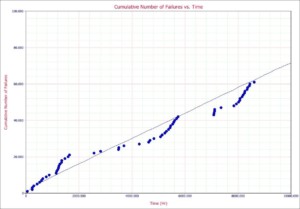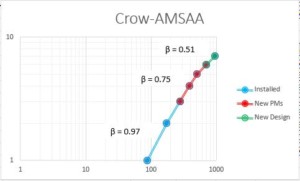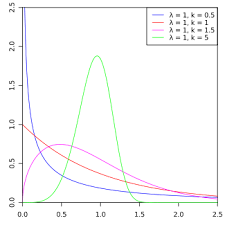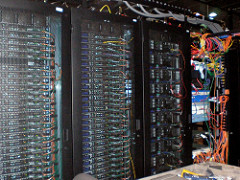Solve. Achieve. Sustain.
Who Is Responsible For Reliability? Everyone!
Why Your Operators Need To Be Part Of Your Reliability Program
 You drive your car (almost) every day, you will immediately notice a new noise, vibration, or feel to the car. Once you detect this you would report the issue to your mechanic (or if yourself and do the repair), and he would investigate the issue. The repair would be made and the car returned to you.
You drive your car (almost) every day, you will immediately notice a new noise, vibration, or feel to the car. Once you detect this you would report the issue to your mechanic (or if yourself and do the repair), and he would investigate the issue. The repair would be made and the car returned to you.
This same approach is what should be happening in your plant. The operators of the plant equipment, operate the equipment every day and know the equipment. […]
What Can You Do With Data?
A Question & Answer Period with Fred Schenkelberg and James Kovacevic on the what can be done with your data and analysis.
 Data and the analyses that use the data can be tricky to manage at best, let along extremely difficult. In this last post of the series on using the maintenance data you have, Fred and James will answer many of the common questions asked about data and the analyses.
Data and the analyses that use the data can be tricky to manage at best, let along extremely difficult. In this last post of the series on using the maintenance data you have, Fred and James will answer many of the common questions asked about data and the analyses.
How does one build a proper asset hierarchy? A hierarchy should be built to the recommendations in ISO 14224. This will ensure all […]
Next Steps in Your Data Analysis
 Nothing keeps a statistician happy like a pile of data. As seen in the previous articles, you can easily use the data you already have to conduct meaningful analysis. This includes Weibull, Crow-AMSAA or a Mean Cumulative Failure analysis.
Nothing keeps a statistician happy like a pile of data. As seen in the previous articles, you can easily use the data you already have to conduct meaningful analysis. This includes Weibull, Crow-AMSAA or a Mean Cumulative Failure analysis.
Digging into a well-managed dataset promises to reveal insights, trends, and patterns that will help improve the line, process, or plant.
Creating a plot or calculating summaries is pretty easy with today’s tools. Yet, are you doing the right analysis or are the various assumptions valid? One critical step in the data […]
The Next Step in Your Failure Data
Improve your failure data to improve the speed and accuracy of your failure & reliability analysis.
 A few years into your reliability journey, you start to struggle to make the improvements you were able to when you first started. Why is this? You were able to systematically eliminate all of the low hanging fruit using the existing data in your CMMS. But now you have to dig deeper to realize the improvements and that requires better data.
A few years into your reliability journey, you start to struggle to make the improvements you were able to when you first started. Why is this? You were able to systematically eliminate all of the low hanging fruit using the existing data in your CMMS. But now you have to dig deeper to realize the improvements and that requires better data.
As Fred discussed in the previous post, A Mean Cumulative Failure Analysis can be another powerful tool […]
First Step in Analyzing Repairable Systems Data
Using the right plot enables your team to know what is working or need improvement.
 Your facility has data and maybe too much data. Using simple plotting may be the key to unlocking how well your maintenance program is performing.
Your facility has data and maybe too much data. Using simple plotting may be the key to unlocking how well your maintenance program is performing.
Building on the concept of reliability growth modeling James Kovacevic described, a convenient way to quickly visualize your repairable system failure data is with a mean cumulative function (MCF) plot.
The Unacceptable and Common Approach
When confronted with a table of numbers our natural inclination is to find the average. It the average time to […]
Quantify the Improvements (or Gaps) In Your Reliability
Using a Crow-AMSAA [Reliability Growth Analysis (RGA)] to Quantify Your Reliability Improvements (or Losses)
 Imagine being able to predict the next time a failure will occur for a piece of equipment without a huge amount of work. Wouldn’t it be nice to know the approximate point in time that a failure will occur on a critical piece of equipment? It is possible, but I am not talking about using MTBF, as it is not a good measure (if you need to understand why, please visit http://www.NoMTBF.com). What I am talking about is a […]
Imagine being able to predict the next time a failure will occur for a piece of equipment without a huge amount of work. Wouldn’t it be nice to know the approximate point in time that a failure will occur on a critical piece of equipment? It is possible, but I am not talking about using MTBF, as it is not a good measure (if you need to understand why, please visit http://www.NoMTBF.com). What I am talking about is a […]
The What & More Importantly, The Why of the Weibull Analysis
How to conduct a Weibull analysis and the questions the analysis will generate.
 Every failure is part of a puzzle. The equipment we are maintaining is trying to communicate with use with each and every failure.
Every failure is part of a puzzle. The equipment we are maintaining is trying to communicate with use with each and every failure.
Often the message is not obvious.
There is the immediate failure. And, if we’re paying attention we can sort out the root cause of the failure along with replacing or repairing the damaged parts. Sometimes though the damage is caused by another issue with the system.
Something was hidden.
Keep in mind that for any complex system there are thousands of […]
Using the Maintenance Data You Already Have
Leverage the existing data in your CMMS to make sustainable improvements to your maintenance program
 Let’s face it, your technicians have been entering data into the CMMS for years, but you haven’t been able to use it to make improvements. Is it because the data isn’t codified or it doesn’t have the right data points? Generally, this is how most maintenance managers will view their data, but it is incorrect. The CMMS does have data that you can use almost immediately.
Let’s face it, your technicians have been entering data into the CMMS for years, but you haven’t been able to use it to make improvements. Is it because the data isn’t codified or it doesn’t have the right data points? Generally, this is how most maintenance managers will view their data, but it is incorrect. The CMMS does have data that you can use almost immediately.
To what extent you can use it may vary, but it will allow […]
How to Sustain the Culture Change
The key to keeping a culture change from going back
 One of the reasons that culture changes fail to change and stay that way is because there is nothing put in place to sustain it. When there is no plan to sustain the change, it will be a flavor of the week and revert back to the old ways. This is the final installment of a series on culture change and if you haven’t already, please go to the first post and start there.
One of the reasons that culture changes fail to change and stay that way is because there is nothing put in place to sustain it. When there is no plan to sustain the change, it will be a flavor of the week and revert back to the old ways. This is the final installment of a series on culture change and if you haven’t already, please go to the first post and start there.
So how do you sustain a change once […]
The Actions To Accelerate Your Culture Change
Hit the ground running and embed the culture change to achieve maximum results
 Your culture change has a plan, it has the right people in place, and you are ready to roll it out. Your change stands a better chance of success than most change programs as you have a plan with the right people. Sometimes changes fail because the change is not embedded quickly, people lose interest and go back to their old ways. If you haven’t already, please start at the beginning of the series with the warning signs that […]
Your culture change has a plan, it has the right people in place, and you are ready to roll it out. Your change stands a better chance of success than most change programs as you have a plan with the right people. Sometimes changes fail because the change is not embedded quickly, people lose interest and go back to their old ways. If you haven’t already, please start at the beginning of the series with the warning signs that […]
